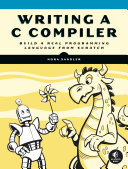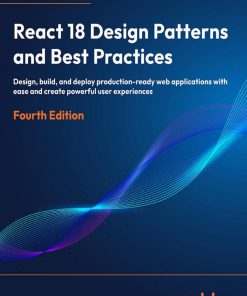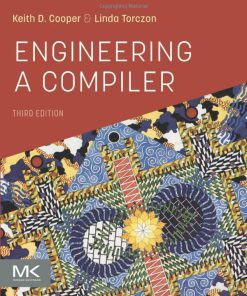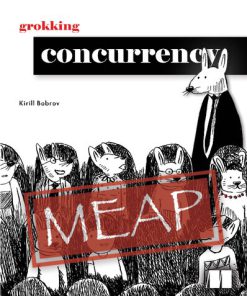Writing a C Compiler Early Access 1st Edition by Nora Sandler ISBN 9781718500433 1718500432
$50.00 Original price was: $50.00.$25.00Current price is: $25.00.
Writing a C Compiler Early Access 1st Edition by Nora Sandler – Ebook PDF Instant Download/Delivery: 9781718500433 ,1718500432
Full download Writing a C Compiler Early Access 1st Edition after payment

Product details:
ISBN 10: 1718500432
ISBN 13: 9781718500433
Author: Nora Sandler
Writing a C Compiler Early Access 1st Edition Table of contents:
Part I: The Basics
1. A Minimal Compiler
The Four Compiler Passes
Hello, Assembly!
The Compiler Driver
The Lexer
The Parser
An Example Abstract Syntax Tree
The AST Definition
The Formal Grammar
Recursive Descent Parsing
Assembly Generation
Code Emission
Summary
Additional Resources
2. Unary Operators
Negation and Bitwise Complement in Assembly
The Stack
The Lexer
The Parser
TACKY: A New Intermediate Representation
Defining TACKY
Generating TACKY
Generating Names for Temporary Variables
Updating the Compiler Driver
Assembly Generation
Converting TACKY to Assembly
Replacing Pseudoregisters
Fixing Up Instructions
Code Emission
Summary
Additional Resources
3. Binary Operators
The Lexer
The Parser
The Trouble with Recursive Descent Parsing
The Adequate Solution: Refactoring the Grammar
The Better Solution: Precedence Climbing
Precedence Climbing in Action
TACKY Generation
Assembly Generation
Doing Arithmetic in Assembly
Converting Binary Operations to Assembly
Replacing Pseudoregisters
Fixing Up the idiv, add, sub, and imul Instructions
Code Emission
Extra Credit: Bitwise Operators
Summary
Additional Resources
4. Logical and Relational Operators
Short-Circuiting Operators
The Lexer
The Parser
TACKY Generation
Adding Jumps, Copies, and Comparisons to the TACKY IR
Converting Short-Circuiting Operators to TACKY
Generating Labels
Comparisons and Jumps in Assembly
Comparisons and Status Flags
Conditional Set Instructions
Jump Instructions
Assembly Generation
Replacing Pseudoregisters
Fixing Up the cmp Instruction
Code Emission
Summary
Additional Resources
5. Local Variables
Variables, Declarations, and Assignment
The Lexer
The Parser
The Updated AST and Grammar
An Improved Precedence Climbing Algorithm
Semantic Analysis
Variable Resolution
The –validate Option
TACKY Generation
Variable and Assignment Expressions
Declarations, Statements, and Function Bodies
Functions with No return Statement
Extra Credit: Compound Assignment, Increment, and Decrement
Summary
6. If Statements and Conditional Expressions
The Lexer
The Parser
Parsing if Statements
Parsing Conditional Expressions
Variable Resolution
TACKY Generation
Converting if Statements to TACKY
Converting Conditional Expressions to TACKY
Extra Credit: Labeled Statements and goto
Summary
7. Compound Statements
The Scoop on Scopes
The Parser
Variable Resolution
Resolving Variables in Multiple Scopes
Updating the Variable Resolution Pseudocode
TACKY Generation
Summary
8. Loops
Loops and How to Escape Them
The Lexer
The Parser
Semantic Analysis
Extending Variable Resolution
Loop Labeling
Implementing Loop Labeling
TACKY Generation
break and continue Statements
do Loops
while Loops
for Loops
Extra Credit: switch Statements
Summary
9. Functions
Declaring, Defining, and Calling Functions
Declarations and Definitions
Function Calls
Identifier Linkage
Compiling Libraries
The Lexer
The Parser
Semantic Analysis
Extending Identifier Resolution
Writing the Type Checker
TACKY Generation
Assembly Generation
Understanding Calling Conventions
Calling Functions with the System V ABI
Converting Function Calls and Definitions to Assembly
Replacing Pseudoregisters
Allocating Stack Space During Instruction Fix-Up
Code Emission
Calling Library Functions
Summary
10. File Scope Variable Declarations and Storage-Class Specifiers
All About Declarations
Scope
Linkage
Storage Duration
Definitions vs. Declarations
Error Cases
Linkage and Storage Duration in Assembly
The Lexer
The Parser
Parsing Type and Storage-Class Specifiers
Distinguishing Between Function and Variable Declarations
Semantic Analysis
Identifier Resolution: Resolving External Variables
Type Checking: Tracking Static Functions and Variables
TACKY Generation
Assembly Generation
Generating Assembly for Variable Definitions
Replacing Pseudoregisters According to Their Storage Duration
Fixing Up Instructions
Code Emission
Summary
Part II: Types Beyond Int
11. Long Integers
Long Integers in Assembly
Type Conversions
Static Long Variables
The Lexer
The Parser
Semantic Analysis
Adding Type Information to the AST
Type Checking Expressions
Type Checking return Statements
Type Checking Declarations and Updating the Symbol Table
TACKY Generation
Tracking the Types of Temporary Variables
Generating Extra Return Instructions
Assembly Generation
Tracking Assembly Types in the Backend Symbol Table
Replacing Longword and Quadword Pseudoregisters
Fixing Up Instructions
Code Emission
Summary
12. Unsigned Integers
Type Conversions, Again
Converting Between Signed and Unsigned Types of the Same Size
Converting unsigned int to a Larger Type
Converting signed int to a Larger Type
Converting from Larger to Smaller Types
The Lexer
The Parser
The Type Checker
TACKY Generation
Unsigned Integer Operations in Assembly
Unsigned Comparisons
Unsigned Division
Zero Extension
Assembly Generation
Replacing Pseudoregisters
Fixing Up the Div and MovZeroExtend Instructions
Code Emission
Summary
13. Floating-Point Numbers
IEEE 754, What Is It Good For?
The IEEE 754 Double-Precision Format
Rounding Behavior
Rounding Modes
Rounding Constants
Rounding Type Conversions
Rounding Arithmetic Operations
Linking Shared Libraries
The Lexer
Recognizing Floating-Point Constant Tokens
Matching the End of a Constant
The Parser
The Type Checker
TACKY Generation
Floating-Point Operations in Assembly
Working with SSE Instructions
Using Floating-Point Values in the System V Calling Convention
Doing Arithmetic with SSE Instructions
Comparing Floating-Point Numbers
Converting Between Floating-Point and Integer Types
Assembly Generation
Floating-Point Constants
Unary Instructions, Binary Instructions, and Conditional Jumps
Type Conversions
Function Calls
Return Instructions
The Complete Conversion from TACKY to Assembly
Pseudoregister Replacement
Instruction Fix-Up
Code Emission
Formatting Floating-Point Numbers
Labeling Floating-Point Constants
Storing Constants in the Read-Only Data Section
Initializing Static Variables to 0.0 or –0.0
Putting It All Together
Extra Credit: NaN
Summary
Additional Resources
14. Pointers
Objects and Values
Operations on Pointers
Address and Dereference Operations
Null Pointers and Type Conversions
Pointer Comparisons
& Operations on Dereferenced Pointers
The Lexer
The Parser
Parsing Declarations
Parsing Type Names
Putting It All Together
Semantic Analysis
Type Checking Pointer Expressions
Tracking Static Pointer Initializers in the Symbol Table
TACKY Generation
Pointer Operations in TACKY
A Strategy for TACKY Conversion
Assembly Generation
Replacing Pseudoregisters with Memory Operands
Fixing Up the lea and push Instructions
Code Emission
Summary
15. Arrays and Pointer Arithmetic
Arrays and Pointer Arithmetic
Array Declarations and Initializers
Memory Layout of Arrays
Array-to-Pointer Decay
Pointer Arithmetic to Access Array Elements
Even More Pointer Arithmetic
Array Types in Function Declarations
Things We Aren’t Implementing
The Lexer
The Parser
Parsing Array Declarators
Parsing Abstract Array Declarators
Parsing Compound Initializers
Parsing Subscript Expressions
The Type Checker
Converting Arrays to Pointers
Validating Lvalues
Type Checking Pointer Arithmetic
Type Checking Subscript Expressions
Type Checking Cast Expressions
Type Checking Function Declarations
Type Checking Compound Initializers
Initializing Static Arrays
Initializing Scalar Variables with ZeroInit
TACKY Generation
Pointer Arithmetic
Subscripting
Compound Initializers
Tentative Array Definitions
Assembly Generation
Converting TACKY to Assembly
Replacing PseudoMem Operands
Fixing Up Instructions
Code Emission
Summary
16. Characters and Strings
Character Traits
String Literals
Working with Strings in Assembly
The Lexer
The Parser
Parsing Type Specifiers
Parsing Character Constants
Parsing String Literals
Putting It All Together
The Type Checker
Characters
String Literals in Expressions
String Literals Initializing Non-static Variables
String Literals Initializing Static Variables
TACKY Generation
String Literals as Array Initializers
String Literals in Expressions
Top-Level Constants in TACKY
Assembly Generation
Operations on Characters
Top-Level Constants
The Complete Conversion from TACKY to Assembly
Pseudo-Operand Replacement
Instruction Fix-Up
Code Emission
Hello Again, World!
Summary
17. Supporting Dynamic Memory Allocation
The void Type
Memory Management with void *
Complete and Incomplete Types
The sizeof Operator
The Lexer
The Parser
The Type Checker
Conversions to and from void *
Functions with void Return Types
Scalar and Non-scalar Types
Restrictions on Incomplete Types
Extra Restrictions on void
Conditional Expressions with void Operands
Existing Validation for Arithmetic Expressions and Comparisons
sizeof Expressions
TACKY Generation
Functions with void Return Types
Casts to void
Conditional Expressions with void Operands
sizeof Expressions
The Latest and Greatest TACKY IR
Assembly Generation
Summary
18. Structures
Declaring Structure Types
Structure Member Declarations
Tag and Member Namespaces
Structure Type Declarations We Aren’t Implementing
Operating on Structures
Structure Layout in Memory
The Lexer
The Parser
Semantic Analysis
Resolving Structure Tags
Type Checking Structures
TACKY Generation
Implementing the Member Access Operators
Converting Compound Initializers to TACKY
Structures in the System V Calling Convention
Classifying Structures
Passing Parameters of Structure Type
Returning Structures
Assembly Generation
Extending the Assembly AST
Copying Structures
Using Structures in Function Calls
Putting It All Together
Replacing Pseudo-operands
Code Emission
Extra Credit: Unions
Summary
Additional Resources
Part III: Optimizations
19. Optimizing Tacky Programs
Safety and Observable Behavior
Four TACKY Optimizations
Constant Folding
Unreachable Code Elimination
Copy Propagation
Dead Store Elimination
With Our Powers Combined …
Testing the Optimization Passes
Wiring Up the Optimization Stage
Constant Folding
Constant Folding for Part I TACKY Programs
Supporting Part II TACKY Programs
Control-Flow Graphs
Defining the Control-Flow Graph
Creating Basic Blocks
Adding Edges to the Control-Flow Graph
Converting a Control-Flow Graph to a List of Instructions
Making Your Control-Flow Graph Code Reusable
Unreachable Code Elimination
Eliminating Unreachable Blocks
Removing Useless Jumps
Removing Useless Labels
Removing Empty Blocks
A Little Bit About Data-Flow Analysis
Copy Propagation
Reaching Copies Analysis
Rewriting TACKY Instructions
Supporting Part II TACKY Programs
Dead Store Elimination
Liveness Analysis
Removing Dead Stores
Supporting Part II TACKY Programs
Summary
Additional Resources
20. Register Allocation
Register Allocation in Action
Take One: Put Everything on the Stack
Take Two: Register Allocation
Take Three: Register Allocation with Coalescing
Updating the Compiler Pipeline
Extending the Assembly AST
Converting TACKY to Assembly
Register Allocation by Graph Coloring
Detecting Interference
Spilling Registers
The Basic Register Allocator
Handling Multiple Types During Register Allocation
Defining the Interference Graph
Building the Interference Graph
Calculating Spill Costs
Coloring the Interference Graph
Building the Register Map and Rewriting the Function Body
Instruction Fix-Up with Callee-Saved Registers
Code Emission
Register Coalescing
Updating the Interference Graph
Conservative Coalescing
Implementing Register Coalescing
Summary
Additional Resources
Next Steps
Add Some Missing Features
Handle Undefined Behavior Safely
Write More TACKY Optimizations
Support Another Target Architecture
Contribute to an Open Source Programming Language Project
That’s a Wrap!
Appendix A. Debugging Assembly Code With GDB or LLDB
The Program
Debugging with GDB
Configuring the GDB UI
Starting and Stopping the Program
Printing Expressions
Examining Memory
Setting Conditional Breakpoints
Getting Help
Debugging with LLDB
Starting and Stopping the Program
Displaying Assembly Code
Printing Expressions
Examining Memory
Setting Conditional Breakpoints
Getting Help
Appendix B. Assembly Generation and Code Emission Tables
Part I
Converting TACKY to Assembly
Code Emission
Part II
Converting TACKY to Assembly
Code Emission
Part III
References
Index
People also search for Writing a C Compiler Early Access 1st Edition:
writing a c compiler
writing a c compiler nora sandler pdf
a compiler writing journey
nora sandler writing a c compiler
Tags:
Nora Sandler,Writing,Compiler,Early Access
You may also like…
Computers - Programming
React 18 Design Patterns and Best Practices, Fourth Edition (Early Access) Anonymous
Computers - Internet & World Wide Web
Computers - Programming
Engineering a Compiler 3rd Edition by Keith D. Cooper 9780128189269 0128189266
Medicine - Natural Medicine
Osteopathy and Obstetrics by Stephen Sandler 1913426246 9781913426248
Computers - Security
Windows Security Internals with PowerShell EARLY ACCESS James Forshaw
Architects & Photographers
Computers - Artificial Intelligence (AI)
The Machine Learning Solutions Architect Handbook – 2nd Edition (Early Access) David Ping
Computers - Programming
Architects & Photographers










